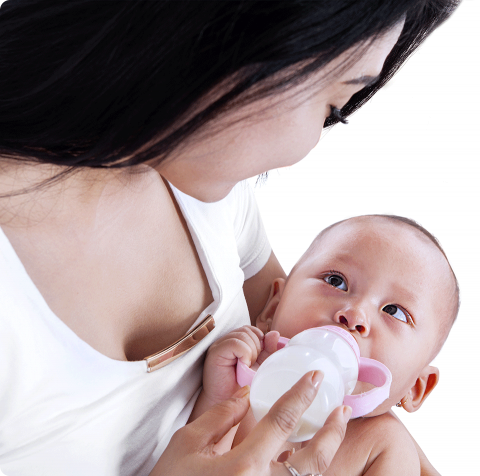Bottle-feeding Your New Baby
Although the current World Health Organisation recommendation is for all babies to be exclusively breastfed for 6 months (WHO 2002), sometimes it is not possible or does not feel possible to breastfeed your baby. In some circumstances, it is not actually wise to attempt to breastfeed your baby. This would include having HIV or if you are taking certain drugs.
The most common way to feed a baby with formula milk is to use a bottle. However if you still plan to breastfeed but need to use formula milk for whatever reason, using a syringe or a special feeding cup is recommended. UNICEF provide a great resource for parents who choose to bottle feed their baby.
Infant Formulae
In these cases, infant formulae provide a way to feed your baby. They are manufactured to take the place of human milk in providing a sole source of nutrition for young babies. The majority of infant formulae can be divided into two groups:
- Whey dominant – in this formula, whey is the dominant protein and the whey: casein ratio is closer to that of human milk, these are marketed as ‘first’ milk;
- Casein dominant – in this formula, casein is the dominant protein and the whey: casein ratio is closer to that of cow’s milk, these are marketed as ‘follow-on’ milk.
The most common way of feeding a healthy term baby with formula milk is via the bottle. There is a range of bottles to choose from and teats that mimic the shape of the nipple. If you have chosen to bottle feed your baby, UNICEF provide a great resource for parents on how to prepare a bottle feed using baby milk powder, at this link.
If you intend to breastfeed your baby, but need additional help with feeding because of a feeding problem or prematurity, there are a range of strategies, including the use of syringe feeding, cup feeding and supplementary feeding.
Complementary / Supplementary Feeds
Supplementary feeds (breast milk replacement) and complementary feeds (breast milk substitutes), do not have a place in the care of a healthy term baby who is breastfeeding, as they interfere with the mother’s ability to establish breastfeeding.
Advantages of Bottle Feeding
- If you are HIV positive, it reduces the risk of the baby acquiring HIV infection
- It can reduce the risk of other harmful viruses such as hepatitis B and hepatitis C being transferred to the baby;
- May reduce the risk of haemorrhagic disease of the newborn as vitamin K is an additive (if the vitamin K injection or oral treatment are unavailable)
- It is the appropriate feeding choice for a mother who is an IV drug user or is taking medication that would be contraindicated in breastfeeding.
- Allows others to participate in feeding the baby.
Disadvantages of Bottle Feeding
Bottle feeding has been described as a risk behaviour (Minchin 2000), because it increases babies’ risk of several infections and disorders including:
- Respiratory infection (twice as likely);
- Otitis media (twice as likely);
- Eczema or a wheeze (twice as likely);
- Diabetes mellitus: juvenile onset of insulin-dependent diabetes mellitus (twice as likely);
- Gastroenteritis (five times more likely);
- Diarrhoea (five times more likely);
- Urinary tract infection (five times more likely);
- Necrotising enterocolitis in preterm babies (20 times more likely).
Other risks of bottle-feeding which are currently being researched include: childhood lymphomas, inflammatory bowel disease, multiple sclerosis, dental occlusions, coronary heart disease, autoimmune thyroid disease, coeliac disease, Kawasaki disease, risk of sudden infant death syndrome and obesity (Macdonald et al. 2012:631-2).
References
- Minchin, M. (2000). Artificial feeding and risk: the last taboo. Practising Midwife 3(3): 18-20.
- Macdonald, S. and Magill-Cuerden, J.(Eds) (2012). Mayes Midwifery 14th Edition. London: Bailliere Tindall Elsevier.
- World Health Organisation (2002). Infant and young child nutrition – global strategy on infant and young child feeding. Geneva: WHO.
QUICK FACTS
Eye-contact
Making frequent eye-contact with your baby during bottle feeding promotes healthy brain development.
Swaping sides
Alternating the arm used to hold your baby during bottle feeding can help reduce the baby's risk of developing flat spots on their head.
6 to 7
The typical number of feeds a bottle-fed baby needs per day.

